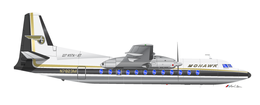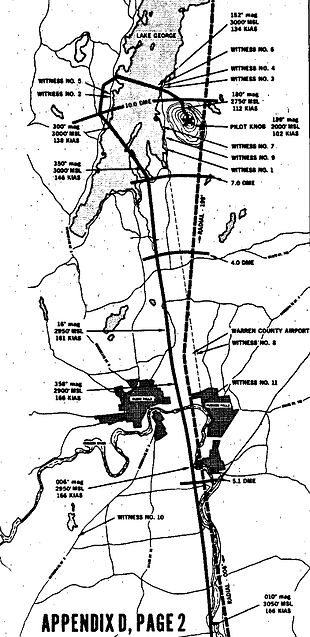- Mohawk Airlines Flight 411
-
Mohawk Airlines Flight 411 
Mohawk Fairchild Hiller FH-227 turboprop, similar to accident aircraftAccident summary Date November 19, 1969 Type Pilot error Site Pilot Knob Mountain, Town of Fort Ann, Washington County, New York, USA
Coordinates: 43°29′33.92″N 73°36′41.32″W / 43.4927556°N 73.6114778°WPassengers 11 Crew 3 Injuries 0 Fatalities 14 (all) Survivors 0 Aircraft type Fairchild FH-227B Operator Mohawk Airlines Tail number N7811M Mohawk Airlines Flight 411, a Fairchild FH-227B twin-engine turboprop, registered N7811M, was a scheduled domestic passenger service operated by Mohawk Airlines, between Albany and Glens Falls, New York. On November 19, 1969, it crashed into Pilot Knob Mountain, killing all 14 passengers and crew on board.[1]
The National Transportation Safety Board (NTSB) concluded that the crash was caused by the captain's improper execution of an instrument approach, combined with a severe downdraft at a low altitude, which resulted in the aircraft descending uncontrollably into terrain.[2]
Contents
History of flight
On the evening of November 19, 1969, at about 20:03 EST, Mohawk Airlines Flight 411, a twin engine Fairchild FH-227B turboprop, departed from Albany International Airport near Albany, New York. It was operating as a scheduled passenger/cargo flight on an instrument flight rules (IFR) flight plan to its destination of Warren County Airport in Glens Falls, New York, 37 nautical miles (69 km) northeast, with an estimated flight time of about 15 minutes.[1]
At 20:07:32 EST, just 4 minutes after takeoff, Flight 411 was cleared by air traffic control (ATC) for "a VOR approach to runway 19". The aircraft overflew the Glens Falls airport and proceeded northbound, subsequently reversing course. Shortly after course reversal, at about 20:20 EST, the aircraft hit trees on the northwest slope of the Pilot Knob Mountain, then impacted a rock cliff from which it fell 34 feet (10 m) and became lodged between trees and caught fire. Of the 11 passengers and 3 crew on board, there were no survivors.[2]
Investigation and final report
The accident was investigated by the National Transportation Safety Board (NTSB). The Flight Data Recorder was recovered intact from the wreckage, but the Cockpit Voice Recorder had been damaged in the post-crash fire and was unusable.[1]
The weather at Glens Falls at the time of the accident was reported as "2,100 (feet) overcast, visibility 7 (miles) in light rain, wind 180 (degrees) at 12 (knots), peak gusts 22 (knots), altimeter 2980, runway 19 in use". The surface temperature was 54 degrees Fahrenheit (12 degrees Celsius).
The investigation revealed that ATC cleared the flight to "the VOR approach", without actually specifying which specific VOR approach procedure was to be used, possibly leaving it to the flight crew's discretion. According to the radio communication transcript, the flight crew did not inquire as to which specific approach was in effect. There were two published VOR approaches at the time, one from the north and one from the south. The northern approach, called "VOR/DME 19", was not legally available to the crew under these circumstances, as Mohawk company policy prohibited reliance on DME as a primary navigational instrument. The other VOR approach, called "VOR 1", was the only one legally available to the flight, and would have required descending while approaching the airport from the south during the final approach segment, followed by a "circle to land" maneuver, landing to the south on runway 19.
Despite this, possibly due to their concerns with passenger comfort (the VOR 1 approach would have required performing the "circle to land" maneuver at a relatively low altitude over the airport to land on runway 19), or possibly by simply being late to set up for the recommended VOR 1 approach (the flight time was only about 8 minutes from takeoff at Albany to the Glens Falls area, with a significant tailwind component of approximately 50 knots), the crew did not execute the VOR 1 approach. Instead, the crew appeared to select an improvised and unauthorized modified version of the VOR/DME 19 approach, which included flying outbound followed by a course reversal at about 10 nautical miles (20 km) north of the airport, over Lake George. As the crew performed what appeared to be an unpublished and unauthorized procedure turn for course reversal on the VOR/DME 19 approach path, they descended prematurely and hit the side of a mountain. It was subsequently determined that a 60-knot (110 km/h) southerly wind created a downdraft effect which, coupled with the aircraft's low altitude over the terrain, contributed to the crash.
In their final report, issued on June 25, 1970, the NTSB determined the following official Probable Cause for the accident:[2]
The captain, while conducting an approach, exceeded his clearance limits and, thereafter, flew the aircraft into a severe "lee of the mountain downdraft" at an altitude insufficient for recovery. No evidence was found to explain why this particular approach was attempted.See also
- List of notable accidents and incidents on commercial aircraft
- Mohawk Airlines Flight 405
References
- ^ a b c "NTSB Report". NTSB. http://libraryonline.erau.edu/online-full-text/ntsb/aircraft-accident-report/AAR70-12.pdf. Retrieved December 14, 2009.[dead link]
- ^ a b c Accident description at the Aviation Safety Network. Retrieved on December 14, 2009.
External links
- Airliners.net Photo of accident aircraft N7811M, a year before the accident, July 20, 1968
- Glens Falls Airport on AirNav Database
← 1968 · Aviation accidents and incidents in 1969 · 1970 → Jan 05 Ariana Afghan Airlines Flight 701
Jan 13 Scandinavian Airlines Flight 933
Jan 18 United Airlines Flight 266
Feb 18 Hawthorne Nevada Airlines Flight 708
Feb 24 Far Eastern Air Transport Flight 104Mar 16 Viasa Flight 742
Apr 02 LOT Polish Airlines Flight 165
Apr 15 EC-121 shootdown incident
Apr 28 LAN Chile Flight 160
Jun 05 Rivet Amber crashAug 29 TWA Flight 840
Sep 09 Allegheny Airlines Flight 853
Sep 12 Philippine Airlines Flight 158
Nov 19 Mohawk Airlines Flight 411
Dec 11 Korean Air Lines YS-11 hijackingIncidents resulting in at least 50 deaths shown in italics. Deadliest incident shown in bold smallcaps. Categories:- Accidents and incidents on commercial airliners in the United States
- Aviation accidents and incidents officially attributed to pilot error
- Aviation accidents and incidents in 1969
- 1969 in New York
- Disasters in New York
- Accidents and incidents on commercial airliners in New York
- Washington County, New York
Wikimedia Foundation. 2010.

